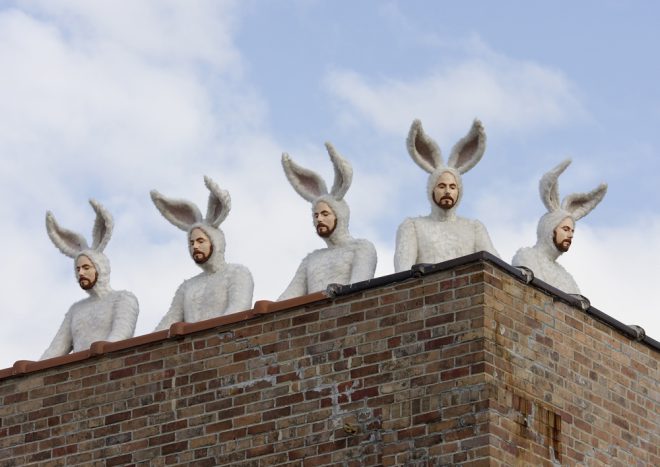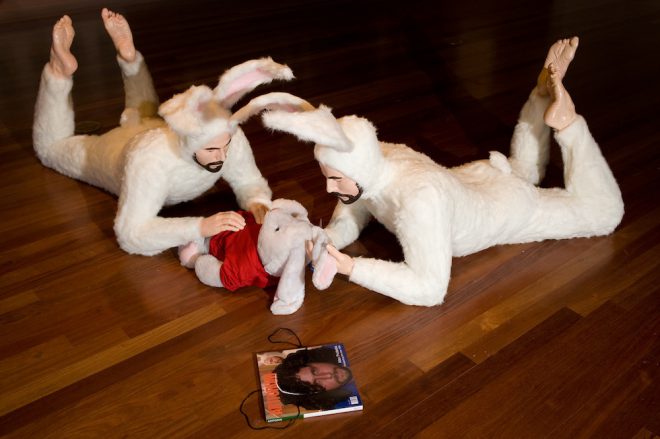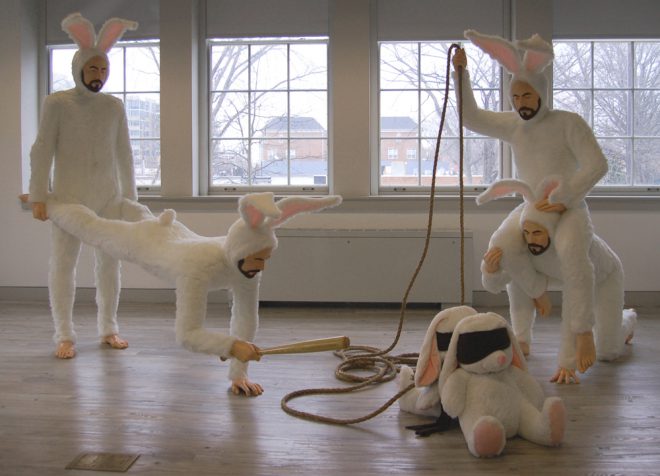Glumly Industrious: An Interview with Alex Podesta
Nick Stillman travels to Grand Rapids, Michigan and speaks with ArtPrize 2014 contestant Alex Podesta.

Alex Podesta, Self-Portrait as Bunnies (The Bathers), 2014. Mixed media installation, visible above water line. Photograph by Gene Meneray.
Editor's Note
After helping New Orleans artist Alex Podesta install a sculpture in Grand Rapids’ Grand River for ArtPrize 2014, I’ve witnessed the gamut of reactions his life-sized human-bunny figures inspire. I’ve seen disbelieving gawkers, couples betting on whether they’re real, dogs cowering in fear, kids screaming with delight, everybody snapping selfies, and sometimes the dismissive or just plain creeped.
Much of Podesta’s meticulous, carefully produced sculptures use animal motifs, and his series of self-portraits in full bunny suits engaged in incongruous busywork has developed into his signature motif. Installations of the “bunnymen,” as the sculptures have invariably come to be referred, are bizarrely confrontational. Whether installed in a gallery, in the ground-floor window of New Orleans’ Saratoga Building, or atop a roof peering down at the street below, Podesta’s work commands total attention and gives none of it back; the figures are forever frozen in industrious, seemingly joyless tasks.
In early 2014 the Arts Council of New Orleans was selected as a venue curator for the ArtPrize 2014 Grand River site, the first time a Southern curator was asked to manage an ArtPrize venue. In September the Arts Council traveled with Podesta to install Self-Portrait as Bunnies (The Bathers) in the river, wading around in wet suits until we found a spot with the appropriate depth. ArtPrize, in just its sixth year, has developed into a full-on street carnival of contemporary art—much of it brutal, some of it outstanding—and a new model for audience engagement. All artists who show are eligible for two $200,000 grand prizes: one determined by a jury, the other voted for by visitors to the show. Podesta’s The Bathers didn’t win one of the prizes, but was a top 25 selection in the popular vote category and one of 20 finalists in the juried category. Irrespective of this type of financial thinking that ArtPrize inevitably inflicts on everyone who engages it, the experience exposed thousands of new viewers to Podesta’s work; the piece was impossible to miss as it bobbed about in the river’s current.
Closer looks reveal a lot in Podesta’s artwork. A close look at The Bathers reveals that the gazes of the two figures facing each other are actually downcast, oblivious to the other’s, sadly unmet. Are the multiple figures in the self-portrait series installations adversaries? Multiple angles of the same personality? Melancholic servants to whatever labor or fetish-enactment they’re up to? In our interview below, I try to lead Podesta down some of those rabbit holes.
-Nick Stillman, Deputy Director, Arts Council of New Orleans
Nick Stillman: Let’s start with the piece that brought us together: Self-Portrait as Bunnies (The Bathers), which we installed in the Grand River for ArtPrize 2014. What’s the background on this piece?
Alex Podesta: Self-Portrait as Bunnies (The Bathers) is the latest iteration of an ongoing series of sculptures that all have the title Self-Portrait as Bunnies. Each individual work is followed by a parenthetical addition. In 2008, I was fortunate enough to be awarded a commission for a piece of public artwork through a joint program administered by the Arts Council of New Orleans and the Joan Mitchell Foundation. I designed a floating cluster of figures to be installed in Bayou St. John near the New Orleans Museum of Art. After months of working through the byzantine process of getting permission from the myriad agencies that have some say over this body of water, we realized we weren’t going to be able to get the location approved soon enough to get the work installed by the program’s launch date. With that in mind, I redesigned the piece as a rooftop installation and City Watch was installed on the roof of the Falstaff building in time for the opening of Prospect.1. This piece is now on a rooftop at the corner of OC Haley and Erato in Central City. The reconfiguration worked out well, but I still wanted to see the original floating design realized. So when the Arts Council was invited to curate the Grand River site for ArtPrize and requested a proposal, I jumped at the chance to finally see a waterborne version of this work.

Alex Podesta, City Watch, 2008. Mixed media installation, installed 35 feet above street level. Courtesy the artist.
NS: The public reaction to Self-Portrait as Bunnies (The Bathers) at ArtPrize in Grand Rapids was fascinating to witness. People stopped in their tracks. There was a common assumption that these life-sized figures were, in fact, real. People had this clear desire to get close to it, talk about it, spend time with it. How did the public reaction in Grand Rapids align or deviate from your expectations?
AP: Over the last few weeks I’ve heard from a few individuals who seemed to both appreciate the work and also get a sense of the introspective—even self-absorbed—reverie that’s being illustrated. I’ve found those communications to be very gratifying, moving even. I’m not sure how to tackle the heart of this question though. I don’t think I’ve ever met an artist who was satisfied with the public reaction to his or her work.
Responses to my work are always varied, and that’s been true of the piece at ArtPrize as well. For many viewers, this work is a surreal oddity to be appreciated simply for its incongruity and allure. Others get drawn further in and, I think, start to sense some of the existential ennui that underlies its creation. I really try to make work that can be appreciated quickly, but that also rewards further investigation.
NS: The gaze in The Bathers is important. It’s piercing but also unfocused, a little glazed. How important is the specificity of that gaze?
AP: That’s key to the work. The two figures are together but not comfortably so. They’re facing each other, but their gazes don’t meet. And they’re the same figure. Not really two at all. I’ve always intended the use of this trope—these adult-sized toy/man chimera—to reference the necessary but uneasy relationship we all have with ourselves, this tricky notion of self. In developmental psychology this is described by Lacan as a mirror stage and by Freud through the evolution of the id and the ego. For the science of psychology, both of these early models have been largely discarded. For the artist, though, they still present rich visual possibilities.
NS: Their interaction doesn’t appear particularly pleasurable. They seem glumly industrious. Am I wrong to perceive some dread there?
AP: No. There’s definitely an uneasiness that could be described as dread. Although I really like your phrase, “glumly industrious.” I think that gets at it very well. Children coming into the galleries where pieces from this series have been installed will often run up and hug them because to them, they’re fun, giant toys. But the figures aren’t having any fun. They’re just working.
NS: “Just working” is a great way to describe your own sculptures. Can you say more about that?
AP: Well, in all of the pieces in this series, the figures are engaged in a task, trying to accomplish some goal. Since they’re ostensibly variations on the same figure, multiple projections of the same psyche, they’re always shown as working on a shared objective from different angles. In some pieces, that task or project becomes a little oblique. In Self-Portrait as Bunnies (How Things Work), for example, one figure is working at explaining the idea of conflict while the other is working at understanding the idea of conflict.
NS: The titles identify all these pieces as self-portraits and I’d be remiss not to go down that road with you. What early ideas led you to the motif of animals, and then the bunny?
AP: I’ve had to address this idea for a number of students from Grand Rapids who have written me over the last couple of weeks looking for guidance with essays they’re writing for high school and college classes. I guess “Write about Your Favorite ArtPrize Entry” is a popular assignment around Grand Rapids come October.
When I decided to go to graduate school, I felt that, to really take advantage of that new situation, I should break from what I’d been doing in the studio up until that point. It seemed that I’d let my work get too removed, too detached, as if I didn’t have a personal stake in it. To combat that idea I began to literally insert myself into the work. At first this took the form of cutting off my hair every few months and using it as a material. Then I started casting bits of myself—my bellybutton, a hand, imprints of my teeth. That eventually grew into making a set of complete figures, which became the first piece in the Self-Portrait as Bunnies series.
I was interested in delving into some key developmental factors from early childhood and trying to apply them in semi-serious, semi-comical ways to the experience of adulthood. Presenting the figures as half man/half bunny was meant to reference the emotional security that many children find in a small, warm blanket or, as it pertained to me, a zip-up, footed pajama suit that I fantasized transformed me into a bunny.
I think identifying the works in this series as self-portraits helps underscore the introspective mental acrobatics that are at the heart of these pieces. I also feel that my particular self—tall, bearded, now middle-aged—is a great counterpoint to the bunny iconography. Bunnies are small and cuddly, Alexes are tall and prickly.
NS: The identical multiples feels allegorical and strange, like a physical manifestation of multiple personalities… not necessarily yours—Alex’s—but a literalization of that construct.
AP: Making multiples seemed right from the outset. I wouldn’t say I was thinking about multiple personalities in a clinical sense, but you could describe these as multiple projections of the same personality. After making the first ones they started to take on a life of their own in the studio. I really fantasized about them in terms of narratives. I became fascinated by the idea that they might be up to something when I closed up the studio at night. That led to the creation of Self-Portrait as Bunnies (Hubris) in which the two boys have become disgusted with their maker, me, and have decided to replace me by making their own new Alex.
Doubling or multiplying the figures was meant as an externalization of that common childhood act of creating and depending on imaginary friends, and was also a sly nod to Lacan's mirror stage of infant development. When these factors were combined with bearded, adult men, it highlighted the adult’s longing for childhood. I mean, most grown-ups that I know have times when they'd rather drift off into the reaches of their daydreams, imaginary friends in tow.

Alex Podesta, Self-Portrait as Bunnies (Hubris), 2007-2008. Mixed media installation. Courtesy the artist.
NS: I see Charles Ray, Robert Gober, Rona Pondick, and in an oblique way Mike Kelley in your work. These are artists whose work became very associated with dialogues around identity and its entanglement with trauma and the body that were prominent in the 1990s. Am I at all close with these influences?
AP: Yes. I’d add Paul McCarthy and Tony Matelli to that list as well. And probably a dozen others who I’d love to pretend I don’t owe anything to! You’re right in identifying the influence of the ’90s. It’s a fairly unremarkable observation that most people continue to esteem the music they were listening to in their twenties for the remainder of their lives. I’ve never thought to compare that phenomenon to visual taste but perhaps there’s something to it. For me, at least, the work that I found most moving in my late teens and into my late twenties is still some of the work that most compels me now.
NS: You were recently included in the excellent "True Colors" show of LGBTQ artists and their straight allies at Antenna Gallery. There are so many potential associations and readings your work prompts. What have been some of the more memorable readings?
AP: Thanks for mentioning "True Colors." It was an excellent show and I was glad to be asked to participate. This was the show’s second iteration and I believe that Holis Hannan, the organizer, is working toward solidifying it as an annual event. Regarding your specific question, I’d say that once a work leaves the studio and enters the public sphere, viewers get to pick up where the artist left off and continue the creative process. I really love how the artist only starts the conversation. I take it as a huge compliment when a viewer spends enough time thinking about a piece of my artwork that they’re able to start layering on new associations.
NS: Could you talk about the decisions you make around conveying bodily expression?
AP: The faces in all of these pieces are the same. Any “expression” is conveyed through the attitudes of hands and feet and by their relative position to one another. Even though I would hardly expect a viewer to catch this, I’ve always considered this approach to relative interactivity to be a subtle reference to Robert Morris’ Untitled (L-beams) pieces—both the works themselves and the performative use of them in some of his choreographed work. By taking multiples of the same object—an L shape made out of plywood—and repositioning them in different ways, Morris was illustrating the fundamental ways that we interact with space, the “attitude” of objects, and how we appreciate and inspect virtually everything in terms of how it relates to us as individuals. By repeating the exact same face in all of these pieces, and rearranging the positioning and gestures of the appendages instead of changing their facial expressions, I’m hoping to leave open the possibility of the viewer making a more reflexive assessment of the work than they might with more straightforward figurative sculpture; that is, they might become more receptive to placing themselves mentally into the work.

Alex Podesta, Self Portait as Bunnies (Bad Boy), 2014. Mixed media installation. Courtesy the artist.
NS: Has performance ever been part of your work?
AP: Not really. But there is, to an extent, a performative element to installing these pieces in a crowded environment.
NS: I’ve been thinking lately about postmodernism and its generally antagonistic relationship to technicianship. It seems to me that a respect—even a fetish—for the handcrafted object has re-emerged in general society as well as art in the last decade. Your work is very sculptural, very technical. What have you been working on or thinking about recently from a technical perspective?
AP: There are whole books to be forged around this one very complicated idea. Craft’s role in sculpture has ebbed and flowed but I don’t think at any point in the last century has craft been allowed to supersede content. Sculpture as a practice unto itself does seem to have shifted from a period of vaguely abject, anti-craft back toward an environment that allows a little more room for craft. I do love work, however, that seems effortless, anti-craft, anti-hierarchical, and anti-labor as a progenitor of quality. To me, these ideas are most eloquently expressed in the work of Richard Tuttle.
Personally, I’ve been a builder since early childhood. Christmas gifts were usually hand tools, never toys. For most of my adult life I’ve made my living as a carpenter. I appreciate and enjoy the pursuit of better and more effective craftsmanship. And while I like the act of solving the specific engineering problems presented by each new piece of artwork I make, I sincerely hope that the elements of craft that go into making these pieces become non-issues when viewing them.
NS: Do you mean that you’re trying to make the craft—the technicianship—disappear and for the image or tableaux to become the focal point?
AP: No, not really. Or yes, perhaps precisely! What I mean is that a fixation with craft, problem-solving, and engineering is a thing that happens in the studio and focusing on those details makes the work better. But for my work to be successful, no matter how much personal satisfaction those efforts give me in the studio, evidence of them needs to stay in the studio. The finished work—my finished work—is best when it just becomes an object that exists independent of any connection to the labor that created it.
Editor's Note
Work by Alex Podesta is currently on view in the group show, “Back to The Front,” at The Front (4100 St. Claude Avenue) through November 2, 2014 and also at the Parlor (3913 St. Claude Avenue) through January 25, 2015.



